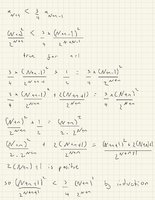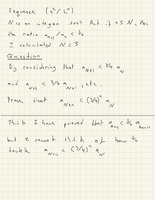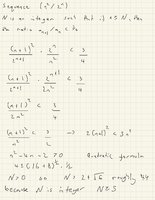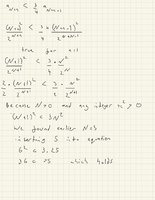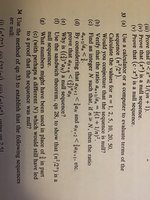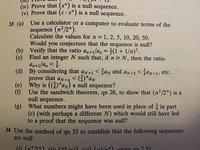You are using an out of date browser. It may not display this or other websites correctly.
You should upgrade or use an alternative browser.
You should upgrade or use an alternative browser.
Sequences.
- Thread starter perusal
- Start date
pka
Elite Member
- Joined
- Jan 29, 2005
- Messages
- 11,978
Why can't these questions be posted in a readable form?
All that I can make out is a sequence \(\dfrac{n^2}{2^n}\)
I cannot understand what is to be done with that sequence.
If one only looks at the first six terms: \(\dfrac{1}{2},~\dfrac{4}{4},~\dfrac{9}{8},~\dfrac{16}{16},~\dfrac{25}{32},~\dfrac{36}{64},~\cdots\)
It is perfectly clear as to the behavior of the sequence.
How the heck are we to know the actual question from what was posted?
After all this is free help, is it too much to ask posters to post readable posts?
All that I can make out is a sequence \(\dfrac{n^2}{2^n}\)
I cannot understand what is to be done with that sequence.
If one only looks at the first six terms: \(\dfrac{1}{2},~\dfrac{4}{4},~\dfrac{9}{8},~\dfrac{16}{16},~\dfrac{25}{32},~\dfrac{36}{64},~\cdots\)
It is perfectly clear as to the behavior of the sequence.
How the heck are we to know the actual question from what was posted?
After all this is free help, is it too much to ask posters to post readable posts?
Thank you for taking the time to reply. Please find attached the requested work. Please note the image starting 6E5 is intended to be read first.You stated that your conjecture was true for n=1. You need to show/prove that it is true for n=1. Why not just say that the theorem is true and be doee? Please show your work. Then I will look further on the work you posted
Attachments
Thank you. I will take a look at this today. Much appreciate.You really need to know that 2N+1/2N = 2.
I think that you lost a 2 in N2<3N2.
You really need to know that 2N+1/2N = 2.
I think that you lost a 2 in N2<3N2.
I had a go writing it with latex.
\((a_n) = \Big(\frac{n^2}{2^n}\Big)\)
Is this the correct way of stating that there is a sequence \(a_n\) and it consists of the terms \(\Big(\frac{n^2}{2^n}\Big)\) for each and every n where n is every natural number excluding 0?
I continue:
\(N\) is an integer such that if n \(\geq\) \(N\), then the ratio \(a_{n+1} / a_n < \frac{3}{4}\).
\(\frac{(n+1)^2}{2^{n+1}} * \frac{2^n}{n^2} < \frac{3}{4}\)
\(\frac{(n+1)^2}{2^{n+1}} * \frac{2^{n+1}}{2n^2} < \frac{3}{4}\)
\(\frac{(n+1)^2}{2n^2} < \frac{3}{4}\)
\(\frac{(n+1)^2}{n^2} < \frac{3}{2}\)
\(2(n+1)^2 < 3n^2\)
\(n^2 -4n -2 > 0\)
Then using quadratic formula with A = 1, B = -4 and C = -2.
\(\frac{4\pm((-4)^2-4*1*-2)^\frac{1}{2}}{2} = 2\pm\sqrt{6}\)
Because \(n\geq1\), N must be equal to the nearest integer greater or equal to \(2\pm\sqrt{6}\).
Therefore, N = 5.
You really need to know that 2N+1/2N = 2.
I think that you lost a 2 in N2<3N2.
I found where I lost the 2 thanks for pointing that out.
N = 5
\(a_{N+n} < \frac{3}{4} * a_{N+n-1}\)
\(\frac{(N+n)^2}{2^{N+n}} < \frac{3}{4} * \frac{(N+n-1)^2}{2^{N+n-1}}\)
When n = 1:
\(\frac{(N+1)^2}{2^{N+1}} < \frac{3}{4} * \frac{(N)^2}{2^{N}}\)
\(\frac{2}{2} * \frac{(N+1)^2}{2^{N+1}} < \frac{3}{2} * \frac{(N)^2}{2^{N+1}}\)
For any integer x, \(x^2>0\). Consequently, we can eliminate the denominator on both sides of the inequality by multiplying by \(2^{N+2}\).
\(2(N+1)^2 < 3N^2\)
Substituting 5 for N:
72 < 75 which holds.
Does this prove that the inequality is true for n=1?
pka
Elite Member
- Joined
- Jan 29, 2005
- Messages
- 11,978
Provo for anyone who tries to learn & use LaTeX. Thank you.I had a go writing it with latex.
\((a_n) = (\dfrac{n^2}{2^n})\)
Is this the correct way of stating that there is a sequence \(a_n\) and it consists of the terms \(\Big(\frac{n^2}{2^n}\Big)\) for each and every n where n is every natural number excluding 0?
I continue:
\(N\) is an integer such that if n \(\geq\) \(N\), then the ratio \(a_{n+1} / a_n < \frac{3}{4}\).
\(\dfrac{(n+1)^2}{2^{n+1}} * \dfrac{2^n}{n^2} < \dfrac{3}{4}\)
Here is a hint for fractions use dfrac{}{}, see above it gives larger displays.
Have a look HERE Is it clear that the limit is zero.
Thank you for the hint.Provo for anyone who tries to learn & use LaTeX. Thank you.
Here is a hint for fractions use dfrac{}{}, see above it gives larger displays.
Have a look HERE Is it clear that the limit is zero.
From looking at your table and by looking at a graph it appears that the sequence converges with zero as n tends to +infinity.
Hopefully, I can clarify the question.
\((a_n)\) is the sequence \((\dfrac{n^2}{2^n})\).
(I am not sure that is the correct notation for sequences, please could you clarify. I wish to state that there is a sequence \((a_n)\) and it consists of the terms \((\dfrac{n^2}{2^n})\)for each and every n where n is every natural number excluding 0? )
Find an integer N such that if n \(\geq\) N, then the ratio \(\dfrac{a_{N+1}}{a_n} < \dfrac{3}{4}\)
From my earlier work posted on this thread I found N = 5.
Thus follows the question I am attempting:
By considering that \(a_{N+1} < \dfrac{3}{4} * a_N\) and \(a_{N+2} < \dfrac{3}{4} * a_{N+1}\), etc. prove that \(a_{N+n} < (\dfrac{3}{4})^n*a_N\)
I am unsure of how to approach the question. I completed an induction proof for \(a_{N+n} < \dfrac{3}{4} * a_{N+n-1}\), however I am not sure if it relevant.
pka
Elite Member
- Joined
- Jan 29, 2005
- Messages
- 11,978
There is no need to clarify the question. Frankly I see little to no point assigning this in an algebra class.From looking at your table and by looking at a graph it appears that the sequence converges with zero as n tends to +infinity. Bingo
If you know calculus using l'Hopital's rule it is a easy proof:
\(\dfrac{{{n^2}}}{{{2^n}}}\mathop = \limits^H \dfrac{{2n}}{{{2^n}\log (2)}}\mathop = \limits^H \dfrac{2}{{{2^n}{{\left( {\log (2)} \right)}^2}}} \to 0\)
I think the questions is concerned with the nature of null sequences in some capacity because the following question asks, why is \(((\frac{3}{4})^na_N)\) a null sequence?There is no need to clarify the question. Frankly I see little to no point assigning this in an algebra class.
If you know calculus using l'Hopital's rule it is a easy proof:
\(\dfrac{{{n^2}}}{{{2^n}}}\mathop = \limits^H \dfrac{{2n}}{{{2^n}\log (2)}}\mathop = \limits^H \dfrac{2}{{{2^n}{{\left( {\log (2)} \right)}^2}}} \to 0\)
I have attached a picture of the question in full if you are interested.
Thanks
Attachments
pka
Elite Member
- Joined
- Jan 29, 2005
- Messages
- 11,978
Why did you post the attachment sideways? It is not readable that way.I think the questions is concerned with the nature of null sequences in some capacity because the following question asks, why is \(((\frac{3}{4})^na_N)\) a null sequence? I have attached a picture of the question in full if you are interes
Sorry, here it is the right way up.Why did you post the attachment sideways? It is not readable that way.

